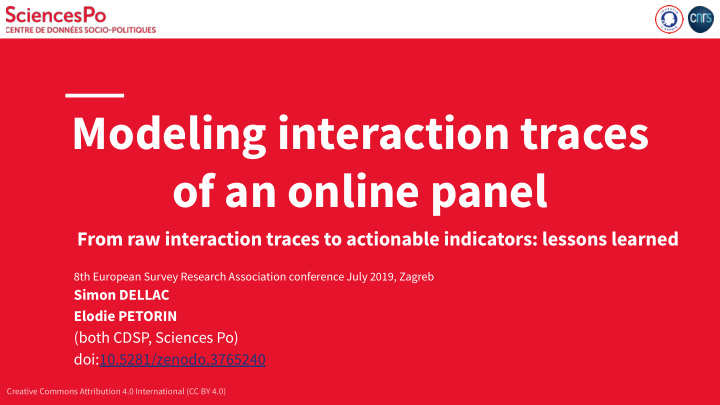



Modeling interaction traces of an online panel From raw interaction traces to actionable indicators: lessons learned 8th European Survey Research Association conference July 2019, Zagreb Simon DELLAC Elodie PETORIN (both CDSP, Sciences Po) doi:10.5281/zenodo.3765240 Creative Commons Attribution 4.0 International (CC BY 4.0)
ELIPSS : Longitudinal Study by Internet for the Social Sciences Probability-based online panel ➔ Monthly questionnaires designed by researchers ➔ Device and internet access provided to panel member ➔ Around 2400 panel members in June 2019 ➔
Panel ELIPSS, bonjour Methodological corpus to standardize processes ➔ Different layers of processes over the years ➔ Recording of every interactions and/or actions ➔ Incident ticket tracking and follow up calls ➔
Panel management system In-house tool ➔ ELIPSS ➔ identification Contact ➔ information Password ➔ modification
Which panel manager ➔ The date ➔ What kind of ➔ The call outcome interaction ➔
Which panel manage r ➔ The date
Incident reason ➔ Resolution Step ➔ Contact type ➔ Interaction abstract ➔
Absence period ➔ Acceptance date ➔ Unavailability reason ➔ How many days in the panel lifetime ➔
Some indicators as of March 2019 76 surveys ➔ 3 556 panelists (2400 still active) ➔ 25 000 phone calls ➔ 510 000 messages (sms, in app, push) ➔ 5 800 tickets ➔ 4 500 follow up letters ➔ 6 million survey paradata records ➔
Panel management: what impact on response behaviour Our intuition: resources allocated for panel management have a large impact on response rate and panel attrition. Stakes: Review the practices + tools developed for each need ➔ Cleanse our large / old database tables ➔ Publish an exploitable dataset ➔ Eventually learn from our design choices ➔
Interaction traces as a dataset Our choice : produce two distinct atomic timelines: The set of events between a panelist and the panel management system ➔ The set of events between a panelist and the surveys ➔ Event types ‘Easy’ to build: follow-ups, incidents, phone call motive, survey ➔ interactions… Hard to build: messages → laborious parsing ➔
Panelist timeline Phone call incident for New device broken tablet provided October 2018 November 2018 December 2018 January 2019 September 2018 Invisible Respondent Respondent Non respondent Sleepers group group group group group Survey 6 not Survey 1 Survey 3 not Survey 2 not Survey 4 not Survey 5 completed completed completed completed completed completed Follow-up push/mail Congratulation push/mail Follow-up calls Follow-up letter Congratulation push/mail
Survey timeline
From raw to derived traces Combined together, enhanced with panelist demographics, raw data become meaningful Questions: What parameters influence response rates/behaviors and how? ➔ Can we identify standard profiles that inform us on response behavior? ➔ Do we have more leverage on certain group of people? ➔
Work in progress Regarding the publication of the dataset: Establishing which interactions to keep ✅ ➔ Building a dataset based on the interactions corpus ✅ ➔ Documentation ❌ ➔ Integrating panelists socio-demographic data ❌ ➔
Lessons learned On general strategies ➔ ◆ More A/B testing throughout the panel lifespan On a development/database perspective ➔ ◆ change of people + change of practices → inhomogeneous data On in-app tools improvements ➔ ◆ incident ticket tracking → missing information about the panelist contact mode
Thank you! elodie.petorin@sciencespo.fr simon.dellac@sciencespo.fr
Recommend
More recommend